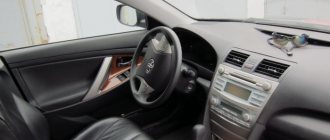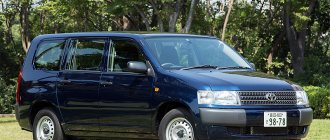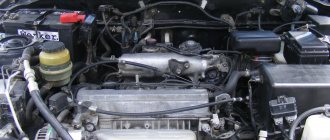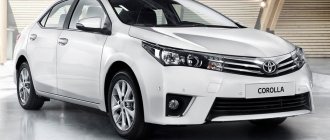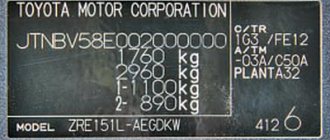This article provides a number of tips for operating a Toyota Auris car. In particular, the operating instructions supplied with the Toyota Auris do not cover the issues of replacing light bulbs and fuses well, and this is exactly what the driver himself often has to do. The fuses are located in two different places: under the hood on the left in the direction of travel and in the cabin under the dashboard. Finding the mounting block under the hood is not difficult, but the fuse box in the passenger compartment is difficult to find unless you specify the exact location. It is located at the bottom left of the dashboard, above the driver's left foot.
The fuses themselves are hidden under the cover. To open the cover, you need to lie with your back on the driver's mat, only then can you see the location of the interior fuse box.
Fuses under the hood
Let's consider the specific case of replacing the side light bulb in the rear left lamp. You need to open the trunk and remove the plastic cover that blocks access to the flashlight. Then you need to move the flat clamps to the middle of the lamp and remove the lamp holder from the headlight, turning it with the lamps down. By turning the burnt-out side light bulb counterclockwise, remove it from the socket. Install a new lamp.
If you try to replace this lamp while the side light is on, a short circuit will occur and the fuse in the passenger compartment will blow. This is exactly what happened to me. This fuse is located in a hard to reach place. You can't change it without a puller. The puller is located in the mounting block under the hood. Therefore, to replace the fuse, you first need to open the hood, remove the cover from the mounting block and take a fuse puller there (in our photo it is made of white plastic), as well as a spare 10 amp fuse.
Cabin fuse box
Spare fuses are located near the puller. Then you need to lie on your back on the mat in front of the driver's seat and remove the cover from the interior fuse box. To do this, press the black button shown in the photo, remove the cover, remove the burnt fuse with a puller and replace it with a new one.
Another car tip: before getting out of the car with the engine running, do not forget to put the automatic transmission lever in neutral. Otherwise, the car may drive away from you with all the ensuing consequences!
In winter, do not skimp on washer fluid. Trying to use regular water during a thaw may lead to it freezing when the temperature drops and you will not be able to use the washer. To defrost the water, you will have to park the car for a long time in a warm garage, since the washer reservoir is located in a hard-to-reach place and it is very difficult to remove it from the car. How well this problem is solved in the “Moskvich” - the tank is easily removed, brought into the apartment and freed from ice in a few minutes. So Soviet cars have their advantages!
Toyota Auris description
Toyota Auris technical characteristics are practical and reliable. The second generation of this car was presented to the general public in Paris in 2012. The model has been changed, both in terms of technical equipment and design, internal and external. However, it did not go beyond the class, remaining a hatchback.
The main advantage of the new Auris is the expansion of the number of additional options. The basic equipment received previously unattainable cruise control, automatic switching on of optics, a vehicle stabilization system, the ability to perform a smooth rise and some other options. There are also more functions that the machine can be equipped with for an additional fee.
The interior of the car has changed slightly:
- Toyota Auris 2007 has received increased dimensions - there is more space for people sitting in the back;
- The luggage compartment remained in standard parameters for the class, it received a volume of 360 liters.
In general, the car turned out to be reliable, without obvious flaws. Only gasoline cars were supplied to the Russian market. Diesel units were also imported to other countries.
The following engines are supplied for the Russian Federation:
- volume 1.3 l and power 99 hp;
- volume 1.6 l and power 132 hp.
The variety of configurations makes it possible to choose an automatic (variable) transmission or a traditional manual transmission. The Auris of the previous generation left its mark on the current one: the manufacturer retained and modified the suspension. At the front it received a sample of MacPherson struts, at the rear it received a multi-link design.
Stylish, reliable, comfortable
Toyota Auris 2008 Toyota characteristics have undoubtedly become higher. The car has become more spacious, it has risen and acquired additional capacity.
External changes include new optics with LED elements and modernization of the power plant.
Unlike the Toyota Auris, the overall dimensions of the 2008 have changed for the better:
- The legroom for rear passengers has increased by 2 cm;
- the trunk has become larger by 10 liters;
- folding the rear seats made it possible to obtain a volume of usable space of 1200 liters.
Is it worth buying?
Toyota Auris, in general, lives up to its name thanks to rare malfunctions. With age, diesel engines are more likely to fail, so gasoline versions are more preferable. Prices for used cars start at 300,000 rubles and end at 600,000 rubles. What do we get in return? Comfortable and spacious interior, simple and intuitive control of on-board devices. Disadvantages include a nondescript design and rather expensive spare parts. The first generation Auris is the choice of motorists who value reliability and safety.
Basic equipment filling
The basic equipment of the car pleases owners from the first acquaintance; it has 6 airbags and climate control. Different configurations have a different set of options, as well as a certain appearance of the car.
For example, a hatchback is available with different types of wheel rims and air intakes. This model has chrome trim on the parts inside the machine.
Auris has four types of equipment:
- Live;
- Active;
- Style;
- Lounge.
The basic package includes the following options:
- ABS, which distributes braking forces;
- VSC stabilization;
- anti-slip system;
- a program that facilitates the process of starting up a hill;
- 7 airbags (the driver’s knees are also not devoid of attention, near which there is also protection);
- mountings for child restraints using the Isofix system;
- the ability to adjust the driver's seat height;
- climate control;
- audio system with support for different modes;
- the ability to fold the rear seats to increase luggage compartment space;
- electric heating and drive of front windows and mirrors.
Dimensions of Toyota Auris 2008:
- length – 4275 mm;
- width – 1760 mm;
- height – 1450 mm;
- ground clearance of Toyota Auris 2008 - 24 cm;
- wheelbase – 2600 mm.
Engine options
Toyota Auris 2008 has a fuel tank capacity of 55 liters, because the car runs on gasoline fuel.
Auris is offered to Russian consumers in three modifications:
- Engine capacity 1.6 liters: basic version, equipped with a six-speed manual transmission, internal combustion engine running on gasoline fuel. Engine power 13 2 hp, acceleration to 100 km/h in 10 s, maximum vehicle speed – 200 km/h. Fuel consumption when driving in mixed mode is 6.3 liters per 100 km.
- Engine capacity 1.6 liters: version equipped with a CVT automatic transmission with seven gears. The engine here is a 4-cylinder petrol engine with a power of 132 hp. Acceleration to 100 km/h is achieved in 10.8 seconds, the maximum speed of the car is 195 km/h. Fuel consumption in mixed mode is 6.1 liters per 100 km.
- Volume 1.8 liters – hybrid: there is an optimized version of the CVT, a petrol engine and an electric motor, together producing up to 136 hp. The model accelerates to 100 km/h in 10.9 seconds. The maximum speed of the hybrid is 180 km/h. Combined gasoline consumption is 4.1 liters per 100 km.
Review from the owner of a Toyota Auris 1.6 5robot. Elegance Hatchback 2008
Author:DenisModel: Toyota Auris 1.6 5 robot. Elegance Hatchback Year of manufacture: 2008 Fuel consumption: 7-9
- Those. characteristics
- Other reviews
- Sale
- Crash test results
Review:
Auris – a city lighter! This is how I characterize this car. The process of changing a sedan to a hatchback was somewhat painful for several reasons: Firstly, there was a stereotype in my head that housewives go shopping in small hatchbacks, and the right guys only drive advanced sedans (at least crossovers or SUVs). Secondly, before Auris, only sedans had to be used, and not lower than D-class. List of used cars: Passat, Vectra, Audi A4, Avensis (all taken with mileage). When the time came to change my horse, owning the latest model pushed me to buy a Toyota; I had the least problems with it. The new Avensis had not yet come out and there was no money for a car of the same class, so I decided to switch to a Corolla or Auris. The Corolla is an ordinary sedan, of which there are many. There is nothing catchy about it. And Auris seemed more interesting to me, but the above stereotypes did not allow me to make a decision quickly. TestDrive put everything in its place. I ordered an Auris 1.6 MMT, the penultimate configuration. All previous cars had a manual transmission, so the “robot”, so disliked by many, was just a godsend for me. And the paddle shifters make you feel almost like you’re in a sports car. Pros: Surprisingly decent handling and road holding for a hatchback. Up to 120 km/h you can relax and enjoy the control. As the car picks up speed, it becomes less predictable, sometimes yawing slightly. Powerful engine. The dynamics are similar to the Avensis with a 1.8 liter engine. The consumption is noticeably less. Perhaps this is due to the robotic gearbox. I often use manual gear shifting, I like to feel a tight connection with the road. The manual mode of the box does not cause any complaints. In automatic mode, switching occurs according to an algorithm known only to the gearbox itself, but you can adapt to it. The cabin in the Auris is the main feature. The backrest of the rear sofa is adjustable in angle of inclination, making it comfortable for even three people to sit in the back. There is sufficient distance to the front seats. The driver's seat has enough adjustments; the back does not ache on long trips. The mind-blowing handbrake, and the part of the dashboard on which the gearshift knob is mounted, will not leave anyone indifferent. The instrument panel is easy to read, with excellent backlighting. Dual-zone climate control is a cool option; you can adjust the temperature separately for the passenger and the driver. Six speakers fill the cabin with decent quality sound (for a standard audio system). For completeness, of course, you will have to install a sub. Cons: Hard plastic creates a fertile environment for the breeding of all kinds of crickets. Oddly enough, over time their number has become smaller, but they cannot be limed at all. I have not driven such cars where there are no extraneous sounds at all. You can always find fault with something. Sound insulation - in the Avensis, the noise from the rubber did not penetrate into the cabin so intrusively, but I can’t even call the Auris a noisy car. I would like to improve this parameter, but for now I'll wait. The trunk, like many hatchbacks, is minimized. Large cargo can only be transported by folding down part of the rear “sofa”. For six months there were no breakdowns, I just changed the front pads at 20,000. Toyota's reliability has not let us down so far. Let me return to the first sentence of my review: “Auris is a city lighter.” I get real pleasure from the car in the city. I am a supporter of dynamic driving, and the compact and maneuverable Auris with a powerful engine allows you to “behave a little.” But everything is within reason! Which I highly recommend to everyone.
Add your review
Review score - 4.16
Viewed 23643 times 66 people voted
Technical specifications
Having clarified the features of the engine for Toyota Auris, the dimensions of the 2008 car, you need to pay attention to the technical characteristics of the model.
- cylinder diameter – 79mm;
- 4 valves per cylinder;
- 4 cylinders;
- piston stroke is 71.3 mm;
- maximum torque is 130 Nm;
- maximum number of revolutions per minute – 4400;
- maximum power – 600 rpm;
- distributed injection;
- in-line engine;
- power – 97 hp;
- engine volume – 1.3 l;
- gasoline fuel.
Toyota Auris, problem with charging.
On diagnostics of Toyota Auris, the reason for the call is that the battery is discharged , problems with starting the engine after parking overnight.
The charging indicator lamp works as expected, lights up when the ignition is turned on and goes out after the engine starts. First of all, we check for current leakage, there is no leakage. Checking the charging.
The battery voltage does not rise above 12.6 volts. After this, we measure the voltage relative to the engine mass. We connect the negative probe of the multimeter not to the battery terminal, but to the engine.
Charging OK! I think you have already guessed where the missing 1.3 volts went. Now connect the multimeter probes between the negative terminal of the battery and the engine.
And here they are, the missing volts. The problem is in the ground power wire from the body to the engine.
After repairing the wire, the voltage returns to normal.
Transmission
Toyota Auris is exclusively front-wheel drive. The engines were paired with a 5 or 6-speed manual transmission or a CVT. In addition, a MultiMode robotic transmission with an electronically controlled clutch was used.
There are cases of premature wear of the input shaft bearing of a 6-speed manual transmission. The malfunction is detected after the engine starts. A noise appears that disappears after pressing the clutch pedal. This usually happens after 200-250 thousand km. For repairs at the service center they will ask about 20-30 thousand rubles.
Among the minor shortcomings are periodic difficulties with shifting gears, especially from “4th” to “5th”. This is usually caused by progressive corrosion of the rods between the lever and the gearbox.
The linkage system of the gear selection mechanism after 100,000 km is the main culprit of shifting problems.
The clutch of a manual transmission usually reaches 200-250 thousand km. A new set is available for 10-15 thousand rubles.
The MultiMode Automated Transmission (MMT) should be avoided.
Often its clutch wears out prematurely (9-14 thousand rubles). The replacement procedure is quite complicated and expensive (8-12 thousand rubles).
After 150-200 thousand km, the clutch release actuator may fail. Often it can be revived. Otherwise, you will have to buy a new one (over 50,000 rubles for the original or about 30,000 rubles for an analogue).
If there were complaints about the operation of the MMT, official services replaced the electronic control unit of the box with a modernized one.
Many owners are unhappy with the robot's reliability. Therefore, in the event of another malfunction, we decided to install the classic Aisin U340E automatic machine. Turnkey work is estimated by specialized services offering a similar service at 50-100 thousand rubles.

